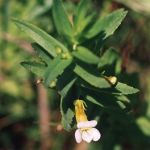| Common Name: |
Hedge Hyssop |
| Botanical Name: |
Gratiola officinalis |
| Genus: |
Gratiola |
| Family: |
Scrophulariaceae |
| Native Location: |
Europe |
| Cultivation: |
Rich, damp to wet, alkaline soil in sun. |
| Propagation: |
By seed sown in spring; by division in spring. |
| Harvest: |
Plants are cut when flowering and dried for use in infusions. |
| Height: |
30-60cm (12-24in) |
| Width: |
20-38cm (8-15in) |
| Hardiness: |
Z5-8 |
| Parts Used: |
Whole Plant |
| Properties: |
A bitter, acrid, diuretic herb that stimulates the heart and uterus and has purgative and emetic effects. |
| Medicinal Uses: |
Internally, formerly used for liver complaints, jaundice, dropsy, enlarged spleen, and intestinal worms. Excess causes abortion, kidney damage, and bowel hemorrhage. |
| Warning: |
Toxic if eaten. |
| Bibliography: |
Encyclopedia of herbs by Deni Brown Copyright © 1995, 2001 Dorling Kindersley Limited. pg 228 |

